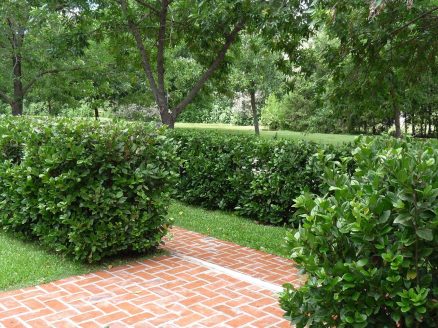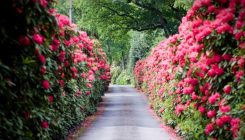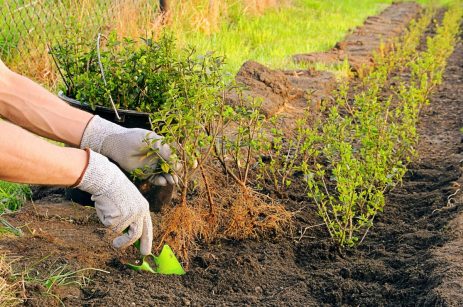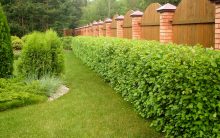Creating a green border and natural protection of the site are the main uses of dense or loose plantings from shrubs. The problem remains, of which it is better to make a hedge to decorate the site, protect it from prying eyes, noise, wind and dust. The advantage of coniferous plants is greenery all year round, and fruiting shrubs give a harvest of delicious and healthy berries.
Material Content:
What is the best way to make a hedge?
The assortment of plants is largely determined by the functions that green fences will perform. You can pick up shrubs of different heights, give them a certain shape with a haircut.

To create a hedge with a height of 50 - 80 cm, the cotoneaster brilliant, undersized spirea, magonia holly, boxwood are suitable. They grow quickly, tolerate pruning, mock lilac, hawthorn. For hedges up to 3 m high, they choose ordinary barberry, yellow acacia, thawed western and biota (plane branch).
Thorny plants are not recommended for the area where small children walk.
Often used plants of unequal height. The lower tier is created from various varieties of golden currants, boxwood, rose hips. Shrubs and trees up to 3 m high are planted behind them. Tiers from plants with contrasting color of leaves or needles look good, for example, a green border made of boxwood against a background of red barberry.
Heat-loving shrubs are less common in the middle lane. Japanese quince, felt cherries and edible honeysuckle beautifully bloom and bear fruit.Their berries are edible, used for home canning.
Fast-growing perennial shrubs: list and description
Before buying seedlings in the nursery, it is recommended to find out about the growth conditions, the requirements of the selected variety to environmental conditions. Fast-growing species are usually acquired in order to save time on creating a green wall.
The most popular decorative and berry plants for hedges or borders:
- Rosehip May and cinnamon.
- Hawthorn is blood red.
- Honeysuckle ordinary.
- Chubushnik is small-leaved.
- Barberry ordinary.
- Privet ordinary.
- Forsythia is European.
- Golden currant.
- Snow White.
- Common lilac.
- Cotoneaster is brilliant.
- Viburnum vulgaris.
- Joster is a laxative.
- Weigela garden.
- Spirea Vangut.
- Elderberry is black.
- Blackberry gray.
- Derain is white.
- Gooseberry.
- Turn
In the above list there are good, "familiar" to almost every summer resident currants, blackberries, rose hips.
Fruit-bearing shrubs are used to create a not too high hedge in areas not polluted by exhaust.
- Barberry (Amur, ordinary, small-leaved, Siberian, Thunberg). The shrub is resistant to weather anomalies, branches well and easily tolerates haircuts, creating impenetrable thickets. The yellowish flowers of barberry bloom in the spring, in the autumn elongated red fruits ripened in the brush ripen. The height of an adult shrub is about 3 m. The forms of barberry with purple leaves are derived.
- European euonymus. High deciduous shrub with plain-looking inflorescences. Hanging fruits decorate the plant - pink-red boxes with a diameter of up to 1.5 cm.
- Privet ordinary. This deciduous shrub has long been used to create fast-growing hedges 1.2 to 3 m high. In the spring, at the ends of the shoots appear brushes of white flowers that exude a strong aroma. Privet easily tolerates a haircut, requires minimal care. The fruits, like that of the euonymus, are poisonous.
- Hawthorn (soft, blood red, slaly-leaved). In spring, the bush is covered with small leaves, white or pink inflorescences. Edible and medicinal fruits of red color ripen in autumn. The hedge of hawthorn is growing rapidly, becoming almost impassable. The plant is unpretentious to soil conditions, tolerates shading, is not damaged by frost. Care for barberry and hawthorn complicates the presence of sharp thorns.
- Elderberry (black, cyst). A medium and tall shrub that attracts attention in spring with lush white inflorescences. In autumn, small fruits ripened in large brushes ripen on the branches. Both species grow rapidly, reaching a height of 5 m.
- Weigela (early, garden, blooming). Moisture-loving and heat-loving shrub. Emerald leaves on thin branches of a red tint, as well as pink or other colors bell-shaped flowers, give the plant a decorative look. Weigela easily propagates by rooting green cuttings. Looks better without cropping.To create a hedge that does not require a haircut, it is better to choose beautifully flowering and berry bushes.
- Felt cherry. Fruit and ornamental shrub to create a wide hedge. The crown of felt cherry is spherical, the height of the plant is 1.5 - 3 m. White flowers appear simultaneously with the blooming of small, as if corrugated, leaves. Fruits - drupes of scarlet or dark red color, sweet and sour taste.
- Honeysuckle ordinary. Tall shrub (about 3 m). Honeysuckle is able to grow in the shade of trees, blooms for a long time. Hedgerow quickly acquires a decorative look. Blue honeysuckle berries can be eaten.
- Viburnum vulgaris. Tall shrubs are used to create dense, wide and tall hedges. Viburnum grows in the shade of tall trees, durable, hardy, does not require special attention. In the spring, white inflorescences bloom on the bushes. In autumn, the scarlet berries of a sour-sweet-bitter taste ripen.It is a medicinal product and raw material for home canning.
- Dogwood is ordinary. Long-lasting fruit shrub, undemanding to care. Sweet and sour dogwood fruits are used fresh, used for medicinal purposes and for home canning.
- Gooseberry. The shrub is suitable for creating barbed hedges, low and medium in height. Gooseberries come into fruition early, characterized by durability (if not affected by diseases). An impenetrable fence with a height of up to 1.5 is created by planting bushes of the varieties "Chernomor" and "Change".
- Golden currant. More durable and productive plant, compared with black currant. It blooms profusely in spring, spreading a pleasant aroma. In the summer, against the background of smooth openwork leaves, the "beads" of ripening berries gleam. They contain pectins, sugars, acids and vitamins. Berries are used for jam, jelly, compote.
- Spirea Vangut. A fast-growing ornamental shrub with a rounded crown decorated in spring with numerous white inflorescences. Spirea is resistant to air and soil pollution, easily propagated by cuttings. It is better not to prune it, but to use it to create a free-growing hedge.
- Snow White. The plant surprises and pleases with its beauty for almost the entire year. Snow-berry, or snowfields, is a deciduous shrub up to 3 m high. In spring, small white or pinkish flowers bloom on thin flexible branches. Snow-white berries ripen in autumn (in different species and varieties, the color of the fruit is different). They are preserved and decorate the bush after snow. Snowfields are durable, little affected by diseases and pests.
- Chubushnik (ordinary, coronet). This plant is often confused with jasmine. Chubushnik quickly acquires a decorative look, looks especially elegant in the spring during the mass blooming of fragrant white flowers 2.5 - 6 mm in diameter. The plant is recommended to use when creating a hedge that does not require a haircut.
- Rosehip (may and cinnamon). Beautiful flowering, fruiting shrubs. False fruits, rich in vitamin C, carotenoids, organic acids, are used in medicine, are used to prepare extracts, oils, decoctions.
- Thorn (blackthorn). Shrub with numerous side shoots covered with thorns. The turn creates an impenetrable green wall. The plant is very tenacious, drought tolerant and durable. Fruits are black with a bluish bloom after the first freeze become tastier.
Thorny bushes are more suitable for a freely growing hedge, without annual pruning.
Evergreens for hedges
A green fence or a wall of coniferous plants is practical and beautiful. Such hedges remain dense and retain decorativeness throughout the year. Green borders from boxwood, magonia, holly holly are not inferior in beauty and durability.
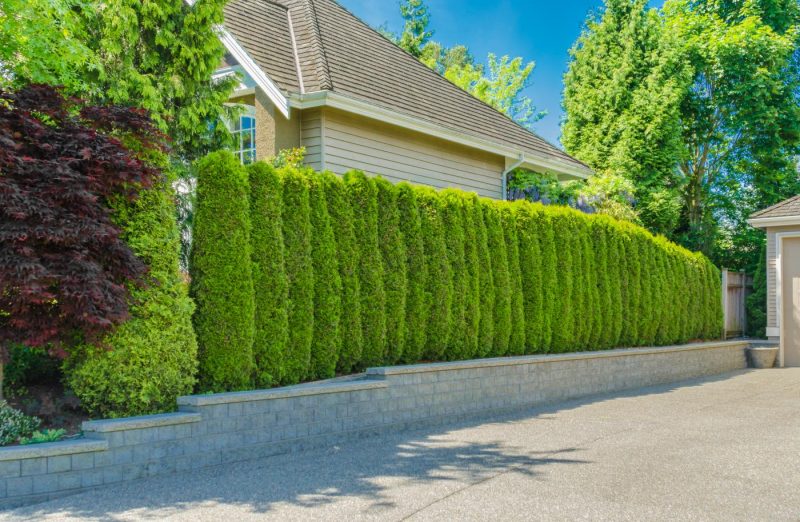
- Magonia is holly. The evergreen shrub attracts with the splendor of large leathery leaves, the beauty of yellow flowers and blue berries.
- Boxwood is a classic of green building. Trimmed fence, elegant topiary, green fence up to 1.5 m high - these are the possibilities of using an evergreen plant in landscape design. Boxwood is not resistant to low temperatures.
- Spruce (prickly, bluish). The advantage of using conifers is resistance to environmental pollution. Using a prickly spruce can create a molded hedge or wall. Blue spruce is more suitable for freely growing hedges. Green beauties form impenetrable thickets.
- Junipers are coniferous shrubs for hedges. The best species for creating an evergreen fence: ordinary M., virgin, Cossack. Virgin Juniper is easy to give with the help of trimming a pyramidal shape. M. Cossack is more suitable for single-row green borders. The shrub needs pruning - removing branches growing to the sides. Juniper ordinary grows slowly and eventually grows to a height of 8 m.Protects the soil and cleans the air of pathogens, is a valuable medicinal plant.
- Thuja western. The coniferous plant is unpretentious, looks beautiful all year. Thuja western is resistant to gas contamination, pests and diseases. Decorative forms with a conical and narrow-columnar crown, golden needles are deduced.
- Biota is eastern. Has the form of a crown and leaflets similar to thuja. Biota is resistant to moisture deficiency. Variegatedly colored, pyramidal varieties were developed that need good lighting, but do not tolerate direct sunlight and drying out of the soil.
It is interesting:thuja: planting and care in the open ground
Hedgerow: landing in open ground
You can arrange the shrubs in one or two rows, annually cut or leave to grow freely. More labor-intensive, time-consuming and expensive is the care of molded green fences (sheared).
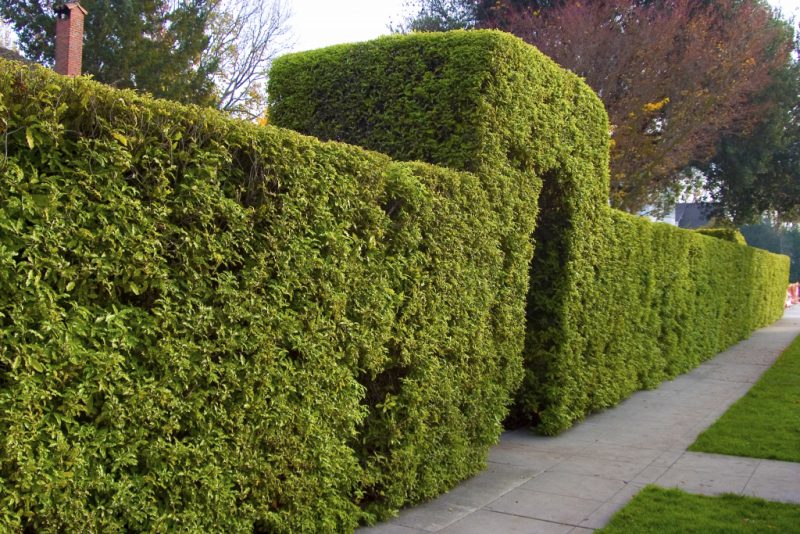
In a dense border at 1 m there are 4 - 5 plants up to 60 cm high. To create a green fence of 1 - 1.2 m, 3-4 bushes per 1 m are planted. If the estimated height of the hedge is more than 1.2 m, then careful selection will be required assortment of plants and placement of 2 - 3 seedlings on an area of 1 m.
Planting a hedge:
- First, mark the area, pull the cord.
- A week before planting, they dig a trench at a distance of 1 - 1.5 from the border, with a width and depth of 50 - 100 cm (depending on the size of the earthen coma around the roots).
- Pour drainage to the bottom then manure or humus, 1 - 2 glasses of nitroammophoska per bush, garden soil (the total height of these layers is at least 20 cm).
- The seedlings are placed in a row or in a checkerboard pattern so that the root neck is at the level of the edge of the trench or slightly lower.
- Spread the roots, sprinkle with earth, slightly compact the soil.
- Water an earthen clod around the roots so that the water is absorbed.
- Add soil to the top of the trench.
- Once again compact and water the soil.
- Sprinkle with mulch on top.
Landing in one row saves time and effort. Such a hedge acquires a decorative look within 3 years. A two- and three-row fence looks elegant in the first year. With this method of creating a hedge, it is recommended to place the seedlings in a checkerboard pattern.
You can plant creeping shrubs in the foreground, create a second tier from medium-sized bushes, a third from small trees.
How to care for plants?
Seedlings trimmed 15 - 20 cm immediately after planting. This technique helps to stimulate the growth of shoots and increases the survival rate of plants. Coniferous and evergreen deciduous shrubs do not cut, only remove damaged and dry branches.
In the next season, pruning is carried out to increase the density of branches. With the help of a haircut give the hedge the desired shape. After reaching the desired height, sanitary and anti-aging pruning of bushes is used.
It is necessary to regularly remove weeds, water the hedge, and loosen the earth in the near-stem circle. Top dressing in spring and summer is combined with watering. The crown is periodically irrigated to wash off the dust. In snowy winters, some species of conifers require tying branches to prevent breakage.
Landscaping ideas for hedges
There are several popular uses for a shrub fence. If necessary, a fast-growing perennial evergreen hedge will close unsightly buildings, divide the site into zones, and give privacy to the corner of the garden. Borders from boxwood or coniferous plants make up paths, flower beds.
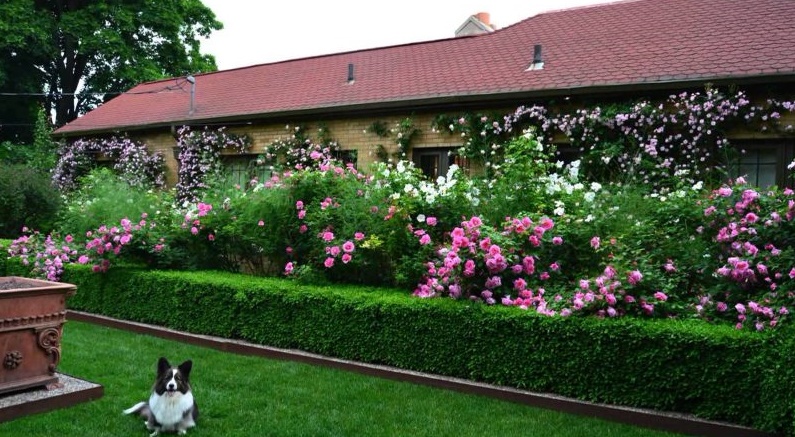
Hedgerows and walls are modern elements in landscape design. They serve as decoration of a summer house, garden or park, close the site from prying eyes, reduce the level of gas contamination and noise. It is important to correctly select an assortment of species and varieties to create a hedge, to do everything correctly when planting, pruning (cutting).Plants must be resistant to pathogens, low temperatures and winds in order to please the owner with their appearance for many years.
Read also:variegated derain


